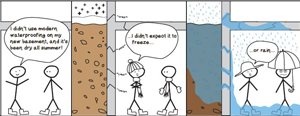 FACT: Freeze/Thaw cycles cause concrete deterioration when the concrete has not been properly waterproofed, and as a result becomes saturated with moisture. Concrete deterioration from freeze/thaw cycles causes millions of dollars in damage every year.
FACT: Freeze/Thaw cycles cause concrete deterioration when the concrete has not been properly waterproofed, and as a result becomes saturated with moisture. Concrete deterioration from freeze/thaw cycles causes millions of dollars in damage every year.
Living in Canada, we are fortunate to see the beautiful complexities of each changing season. The hot, sometimes humid summers give way to the burst of reds and yellows of autumn, lighting up our Thanksgiving scenic drives. By December, most cities have had the first snowfall of many for the year, and we take advantage of the many winter sports and activities that bind our communities in fun and tradition. As spring emerges, and our creeks and rivers rise, our environment gives us the fresh reminder of new beginnings.
These temperature extremes, however, like to play havoc on our infrastructure. Deterioration of concrete from freeze thaw actions may occur when the concrete is critically saturated, which is when approximately 91% of its pores are filled with water. This may sound like a lot of saturation, but consider that curing concrete naturally cracks while it dries and settles. Over time, larger cracks, or deterioration of external sheet waterproofing membranes allow more water to enter the concrete, which can quickly lead to high saturation levels.
When water freezes to ice, it occupies 9% more volume than that of water. If there is no space for this volume expansion in a porous, water containing material like concrete, freezing may cause distress in the concrete. Distress to critically saturated concrete from freezing and thawing will commence with the first freeze-thaw cycle and will continue throughout successive winter seasons resulting in repeated loss of concrete surface. (Source: http://www.concrete-experts.com/pages/ft.htm )
Costly emergency repairs or even replacement of critical infrastructure, such as bridges or tunnels, has led to major headaches for many cities. Montreal, Canada, for example, has experienced multiple tragic instances of crumbling concrete infrastructure since 2009, largely blamed on the lack of drainage on affected overpasses and bridges. Combine the design flaws with the average temperature throughout the year in Montreal ranging from -8.9°C (16°F) to 22.3°C (72°F), with the approximately 70,000 tons of de-icing salt applied each year in the city, and the outcome of these structures looks quite bleak.
Reducing water ingress is a critical factor in making durable concrete.
As concrete technology advances to mitigate these structural failings, Permeability Reducing Admixtures (PRAs), are increasingly being used to provide an additional level of protection from within. PRAs are chemical admixtures used to protect concrete from the damaging effects of water and water borne chemicals. These particular admixture types are distinct tools for making durable concrete and with proper selection and use, PRAs (often referred to as “integral systems”) have been used to replace surface-applied sealers, water repellents and membranes.
The selection of an appropriate PRA depends on the service conditions, and how water is expected to enter the concrete. A document from The American Concrete Institute (ACI), (ACI 212.3R-10 Report on Chemical Admixtures for Concrete), subdivides PRAs into two categories based their performance properties:
- PRAN (Permeability Reducing Admixture for Non-Hydrostatic Conditions) admixtures are intended for applications that are not subject to hydrostatic water pressure and are sometimes called damproofing admixtures. Most PRAN’s contain water repellant chemicals that shed water and reduce water absorption into the concrete.
- PRAH (Permeability Reducing Admixture for Hydrostatic Conditions) are primarily intended for use in concrete that is exposed to water under pressure and are sometimes called waterproofing admixtures. They are able to withstand the high hydrostatic pressure for applications such as basements, tunnels and water containment structures.
Altogether, the advantages of PRAs bring a concrete structure both short and long-term benefits: cost efficiency and time savings during construction; while also providing quality, lasting support against water damage to enhance the entire structures durability.
Krystol Internal Membrane (KIM) is an integral crystalline concrete waterproofing admixture; and a PRAH. When combined with water, KIM’s proprietary chemicals react to form millions of needle-like crystals. These crystals grow and fill the capillary pores and micro-cracks in the concrete, blocking the flow of water. As time passes and stresses form new cracks, any incoming moisture causes the crystals to reactivate – ensuring continuous waterproofing throughout the entire life of the structure, and actually growing increasingly effective over time.
Product Benefits
- Lowers the cost of waterproofing by as much as 40%
- Available with or without Air-Entraining
- Helps to shave weeks off of construction schedules
- Reduces the cost of maintenance and repairs
- Increases reliability and quality control
- Increases revenues with a larger building footprint
- Safe for contact with potable water and Certified by NSF to NSF/ANSI Standard 61 Drinking Water System Components – Health Effects
- Winner of the Most Innovative Product Award at World of Concrete in 2003


 FACT: Freeze/Thaw cycles cause concrete deterioration when the concrete has not been properly waterproofed, and as a result becomes saturated with moisture. Concrete deterioration from freeze/thaw cycles causes millions of dollars in damage every year.
FACT: Freeze/Thaw cycles cause concrete deterioration when the concrete has not been properly waterproofed, and as a result becomes saturated with moisture. Concrete deterioration from freeze/thaw cycles causes millions of dollars in damage every year.
